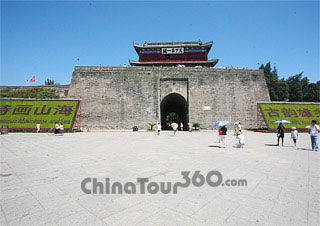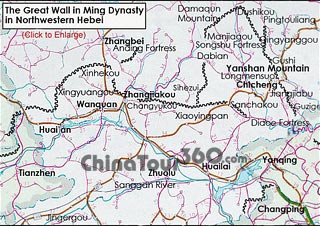 Jiaoshan Great Wall
Jiaoshan Great Wall Shanhaiguan Mingqing Street
Shanhaiguan Mingqing Street Shanhaiguan Pass
Shanhaiguan Pass
![]() Hebei Great Walls:
Hebei Great Walls:
Shanhaiguan Pass First Pass under Heaven
Laolongtou Xifengkou Zijingguan Pass
Temple of Meng Jiangnü
![]() Introduction: There are two walls that appear to writhe snake-like over the mountains in the northwest territory of Hebei Province. From Laolongtou south to Shanhaiguan Pass to Mashikou in the west, the wall in the north stretches about 1,200 kilometers (745 miles). The inner wall in the south is 800 kilometers (497 miles) long from the Mutianyu through Zhangjiakou, Baoding, Shijiazhuang, and Xingtai to Handan. With more than 300 passes and countless towers, the most famous sections are located in Tangshan, Qinhuangdao, Zhangjiakou, and Baoding in Hebei, as well as on the borders between Hebei and Liaoning, Tianjin, Beijing and Shanxi.
Introduction: There are two walls that appear to writhe snake-like over the mountains in the northwest territory of Hebei Province. From Laolongtou south to Shanhaiguan Pass to Mashikou in the west, the wall in the north stretches about 1,200 kilometers (745 miles). The inner wall in the south is 800 kilometers (497 miles) long from the Mutianyu through Zhangjiakou, Baoding, Shijiazhuang, and Xingtai to Handan. With more than 300 passes and countless towers, the most famous sections are located in Tangshan, Qinhuangdao, Zhangjiakou, and Baoding in Hebei, as well as on the borders between Hebei and Liaoning, Tianjin, Beijing and Shanxi.
The wall in Hebei is without doubt the longest and the best preserved section in China. It has taken on an important role in the tourism industry of the province over the last few decades, and is expected to attract more and more tourists from all over the world in future. As an old Chinese saying goes: "He who doesn't reach the Great Wall is not a real man," for anyone who wants to comprehend the magnificence of the walls, those sections Hebei cannot be missed.
|
|
![]() History: Sections dating from the Warring States Period (476BC - 221BC) to the Ming Dynasty (1368 - 1644) were found in Hebei province. In the Warring States Period, the Zhao State, Yan State, and Zhongshan State built walls along their own borders. The walls of these three states are mainly located in Baoding, Zhangjiakou and Chengde cities. After Qin Shihuang (the first emperor of the Qin Dynasty) unified the county, he ordered the connection of the walls of the Yan, Zhao, and Qin States as a defense against the Huns. Later in the Northern Wei, the Northern Qi, and the Jin Dynasties, walls were constructed on a large scale in order to defend against the northern ethnic tribes and to consolidate the ruling powers. However, the walls described above suffered demolition on a large scale.
History: Sections dating from the Warring States Period (476BC - 221BC) to the Ming Dynasty (1368 - 1644) were found in Hebei province. In the Warring States Period, the Zhao State, Yan State, and Zhongshan State built walls along their own borders. The walls of these three states are mainly located in Baoding, Zhangjiakou and Chengde cities. After Qin Shihuang (the first emperor of the Qin Dynasty) unified the county, he ordered the connection of the walls of the Yan, Zhao, and Qin States as a defense against the Huns. Later in the Northern Wei, the Northern Qi, and the Jin Dynasties, walls were constructed on a large scale in order to defend against the northern ethnic tribes and to consolidate the ruling powers. However, the walls described above suffered demolition on a large scale.
The walls in the province were mostly built in the Ming Dynasty. Generally, the wall is 5-8 meters high and 5 meters wide. Being an essential defense system which surrounded the center of the Ming Administration-Beijing, the walls has the highest architectural quality. Mostly built with huge bricks and stones, it is majestic and strategically solid.
![]() Attractions: Dozens of essential sections here are world famous, such as the Laolongtou, Shanhaiguan Pass, First Pass under Heaven, Jiaoshan Great Wall, and Temple of Meng Jiangnü in Qinghuangdao; Xifengkou Gateway, Panjiakou Gateway, and Qingshanguan Gateway in Tangshan; and Zijingguan Pass in Baoding.
Attractions: Dozens of essential sections here are world famous, such as the Laolongtou, Shanhaiguan Pass, First Pass under Heaven, Jiaoshan Great Wall, and Temple of Meng Jiangnü in Qinghuangdao; Xifengkou Gateway, Panjiakou Gateway, and Qingshanguan Gateway in Tangshan; and Zijingguan Pass in Baoding.
Being the east end of the long wall in China, Laolongtou meets the sea like its name literally implies 'the Head of the Old Dragon'; the dragon here refers to the Ten-thousand-kilometer Great Wall. Shanhaiguan Pass is located 4 kilometers (2.48 miles) west of Laolongtou, which enjoys fame as the "First Pass under Heaven". It is also the key path from the central plains to the northeast China. The Jiaoshan Great Wall is the first section of the walls in Hebei province that traverses mountains. There are three passes in a canyon 7 kilometers (4.35 miles) north-east of Shanhaiguan Pass, named 'Sandaoguan Pass', which as a reversal of the wall is the uniqueness of the China Great Wall. Xifengkou Gateway was an important stronghold west of Shanhaiguan Pass and also impressive. It is now submerged by water due to the construction of Panjiakou reservoir from a ridge on its east bank. The Temple of Meng Jiangnü 6 kilometers (3.7 miles) east of Shanhaiguan Pass is a cultural relics which carries a touching love story.
![]() Hebei Great Wall Photos: Shanhaiguan
Hebei Great Wall Photos: Shanhaiguan









